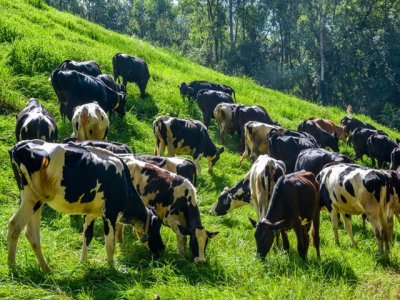Supplementing diets for pastured-raised dairy cows may boost milk yields

A blended, yeast-based additive may improve dry matter intake and milk production for pasture-raised dairy cows facing heat stress conditions, say researchers.
An international team of researchers from Brazil and the US explored the use of a yeast and vitamin B12-based feed additive as a way to mitigate the influences of heat stress in pasture-raised dairy cows
“The objective of this study was to determine the effects of OMN on pasture intake, milk yield and composition, blood metabolites, body temperature, and RR [respiratory rate] of grazing cows under high THI [temperature-humidity index] environment,” the researchers said.
The feeding trial results showed that cows receiving the feed additive had increased pasture intake, milk and milk fat yield and higher milk fat content. Cows on the supplemented diet had lower urea nitrogen (N) concentration and reduced somatic cell counts in their milk.
However, the additive did not alter body weight or cow’s body condition score, the researchers said. The use did increase blood glucose and ionized calcium levels and it lowered alkaline phosphate concentration along with rectal temperature, respiration rate and body surface temperature.
“Supplementation may alleviate the negative effects of high THI [temperature-humidity index] on dairy cow performance,” they added. “This study provides evidence that OMN increases forage intake, milk yield, and milk fat content of cows, and these outcomes are associated with a reduction of body heat load.”
However, more research is needed to understand how the feed additive interacts with heat stress in cows, they said.
Heat stress in dairy cows
Cows raised in an environment that has a temperature-humidity index (THI) about 72 or that sees temperatures above 25c can demonstrate signs of heat stress – including increased rectal temperatures (RT) and higher respiration rates (RR), the researchers said.
When facing stress cows tend to lower metabolic heat production through a drop in milk synthesis and immune system functioning.
A commercial feed additive (OmniGen-AF) was developed to have immunomodulatory effects using “silicon dioxide, brewers, dehydrated yeast, niacin, vitamin B12, riboflavin-5-phosphate, d-calcium pantothenate, choline chloride, biotin, thiamine monohydrate, pyridoxine hydrochloride, menadione dimethylpyrimidinol bisulfate, folic acid, sodium aluminosilicate, diatomaceous earth, calcium carbonate, rice hulls, and mineral oil,” they said.
However, along with influencing the immune system, the additive (OMN) has been linked to a reduction in heat stress symptoms in confined dairy cows, they said.
In past research with confined cows in different physiological states, the feed additive has been tied to lower RR and improved milk yield in cows before and following parturition and lower vaginal temperatures and reduced somatic cell counts in milk for cows at the start of milk production.
“Although there is evidence that dietary supplementation with OMN aids thermoregulation of confined cattle, literature lacks data on OMN effects in grazing dairy cows,” the researchers said. “We hypothesized that OMN would reduce overall body temperature and increase milk yield of cows.”
Feeding trial details
In the feeding trial, 36 cows in a rotational grazing system were given one of two diets for a period of 84 days, the researchers said.
The diets included a control – corn silage and concentrate mixture provided after milking and that feed with 50g/d of the supplement top-dressed, they said. “Fixed amounts of corn silage (6.5 kg DM/d) and concentrate were offered in front of headlocks avoiding cross feeding,” they added.
“Concentrate amounts for each cow were adjusted weekly according to average milk production [1:3, concentrate (kg as-fed) to milk yield (kg/d) ratio] from previous 7 d,” they said.
For three days prior to the start of the feeding trial cows were tracked for milk yield, milk composition, body weight, body condition score (BCS), body temperature and blood were collected and analyzed, the researchers said.
Pasture and feed ingredients were sampled every 21 days to check for dry matter, ash, crude protein, ether extract, acid detergent fiber and lignin, they said. Pasture intake was recorded daily, and both feed and fecal samples were collected.
Milk production was noted weekly and samples were taken for analysis, they said. Blood samples were gathered every 21 days.
Results
Cows on the supplemented diet had increased intake of total dry matter and pasture, the researchers said. They also generated more milk and more fat-corrected milk and had higher milk fat content compared to cows on the control diet.
Supplemented cows also had a drop in milk urea nitrogen concentration and somatic cell count, they said. Blood concentrations of glucose and ionized calcium increased while levels of aspartate aminotransferase and alkaline phosphatase fell.
No interactions were found with body weight or body condition score, they said. “Cows fed OMN had lower temperature of body surface and muzzle, and RR than those ones in CON group,” they added.
“There was a treatment and time interaction effect on rectal temperature and temperature of face and eyes,” the researchers said. “Feeding OMN resulted in lower rectal temperature on d 21, 42, 63, and 84, whereas the lowest difference in rectal temperature between treatment groups occurred on d 84. Animals fed OMN showed lower face heat emission on d 21 and 63. OMN reduced eye heat emission on d 42 and 63.”
There also was a “positive correlation” between rectum, face, eye and muzzle temperature and respiration rate, they said.
Source: Livestock Science
Authors: J. Gandra, C. Takiy, T. Del Valle, N. Orbach, I. Ferraz, E. Oliveira, R. Goes, E. Gandra, T. Pereira, J. Batista, H. Araki, J. Damiani, A. Escobar
Có thể bạn quan tâm
 Infrared tech may support cattle herd improvement
Infrared tech may support cattle herd improvement Science-driven system opens new doors for optimizing feed efficiency.
 Muddy pastures interfere with livestock grazing
Muddy pastures interfere with livestock grazing Compression from tires and ruts from cattle or horse traffic can permanently damage pastures, and heavy rainfall can worsen that damage.
 Genomics link beef cattle to production environment
Genomics link beef cattle to production environment Grant issued in 2015 starting to match cattle to specific environments in U.S.